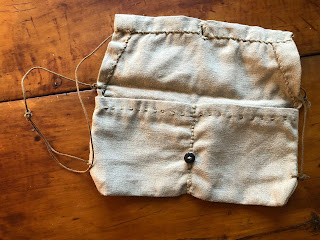I've been throwing myself into some research of Culpepper Minute Battalion. I've been falling in with the recreated NWTA unit since I was a teenager and recently there has been a push within to try steering into some more updated research or rather, better interpretation of the research that has been there all along. So I've been enjoying looking through Greg Sandors amazing compendium "Journal of the Public Store at Williamsburg 1775-1776".
One of the real problems with these "militia" style battalions is we tend to think that "brought from home" means "anything I have laying around becomes fair game" or "wearing just a waistcoat works cause that's all I had. I'm just a poor farmer after all". Getting ourselves further away from this founders day pageant costume approach to living history where everything was homespun and your wife sat weaving her own cloth in the cabin and updating to a view of the incredible economy and vast resources of the 18th century even on the frontier is a struggle.
We know from the records they received a lot of oznaburg and linen for hunting shirts. Initially it was thought that these shirts were a pullover style smock. Original recreated Culpepper units would dye them or make them out of green linen or cotton and paint or stitch in big letters LIBERTY or DEATH on the front. It looked cool, but more recent scholarship on the hunting shirt seems to indicate a split front, caped shirt with Liberty or Death embroidered on the breast as a more likely option.
 |
| Culpepper Minute Battalion 1996 |
 |
| The more plausible appearance of the Minute Battalion Hunting Shirt |
Captain William McLanahans company received "49 yards of Blue thicks for Legings" while receiving "best blue stroud for officers".
Another cool aspect that I've at present never seen anyone carry is the duck shot pouch. In October of 1775 the battalion received "88 yds of stout duck for pouches".
This pouch would fit the bill and was probably a cheap source to get guys supplied with a way to carry ammunition. The following example was made by Adam HL based on an original.
There are so many cool details one could bring to this impression and I hope more effort will be made to dispense with the "brought from home" catch all militia impression to something a bit more representative of what we find in the sources.
This brought from home idea, the homespun etc should be contrasted with what we actually know about the availability of goods in the backcountry or at the edge of the frontier. In Virginia in the early 1770s, John Hooks store is a prime example. In her book "Buying in the the World of Goods", Ann Smart Martin writes the following :
"The quality, variety and fashionability of the items he stocked belie the pervasive currently held notions of rugged, self-sufficient, backcountry life ; his customers could thumb through the Spectator or Johnsons Dictionary and handle Backgammon boards, china tea cups and feather plumes."
She goes on to list an incredible amount of items and goods that certainly turn the homespun rugged frontiersman narrative on its head. It's not that in some places and in some cases this ruggedness didn't exist, we just need to be careful and specific about when, where, who and what when we are portraying something in history.
In the case of Culpepper's, these men would have been aquanted with the "fashionability" of life in 1770s Virginia and it would reflect in their clothing and accouterments and items "brought from home".


